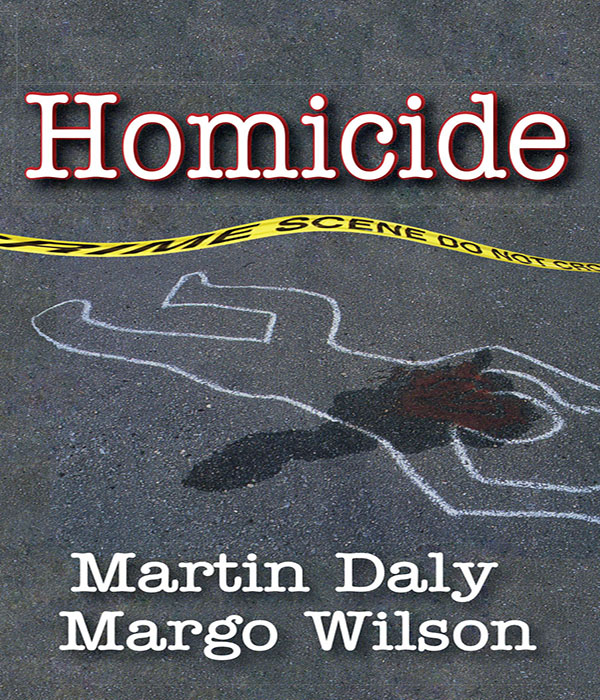Contents
Homicide
Homicide
Martin Daly
Margo Wilson

Published 1988 by Transaction Publishers
Published 2017 by Routledge 2 Park Square, Milton Park, Abingdon, Oxon OX14 4RN
711 Third Avenue, New York, NY 10017, USA
Routledge is an imprint of the Taylor & Francis Group, an informa business
All rights reserved. No part of this book may be reprinted or reproduced or utilised in any form or by any electronic, mechanical, or other means, now known or hereafter invented, including photocopying and recording, or in any information storage or retrieval system, without permission in writing from the publishers.
Notice:
Product or corporate names may be trademarks or registered trademarks, and are used only for identification and explanation without intent to infringe.
Library of Congress Catalog Number: 2013005500
Library of Congress Cataloging-in-Publication Data
Daly, Martin, 1944
Homicide / Martin Daly and Margo Wilson.
pages cm
1. HomicidePsychological aspects. 2. Behavior evolution.
I. Wilson, Margo. II. Title.
HV6515.D35 2014
364.152-dc23
2013005500
ISBN-13: 978-0-202-01178-3 (pbk)
Contents
Killing ones antagonist is the ultimate conflict resolution technique, and our ancestors discovered it long before they were people. Homicide is a life-and-death issue to the protagonists, of course, but it is also profoundly interesting to those not immediately involved. We invest what is arguably a disproportionate amount of attention, money and expertise in solving, trying and reporting homicides, as compared to other social problems. The public avidly consumes accounts of real-life homicide cases, and murder fiction is more popular still. Nevertheless, we have only the most rudimentary scientific understanding of who is likely to kill whom and why.
Psychiatrists and psychologists have tried to characterize the mind of the murderer, but he has remained a shadowyindeed an illusoryfigure: Most killers turn out to be ordinary folks, and much more progress has been made toward explaining their actions in terms of culture and circumstance than in terms of personality and psychopathology. But the fact that homicide is a behavioral potentiality of normal people does not mean that a psychological account is superfluous, any more than the normalcy of sexuality obviates a psychological understanding thereof. How do normal people weigh the interests of others against their own? In defense of whom or what might a normal person kill? How do mutual valuations arise and how do they influence our willingness to inflict harm? When are normal people in conflict prepared to contemplate violence and why?
This book is an exercise in evolutionary psychology: the attempt to understand normal social motives as products of the process of evolution by natural selection. There is simply no question that this is the process that created the human psyche, and yet psychologists seldom ask what implications this fact might have for their discipline. We think that the implications are many and profound, touching on such matters as parental affection and rejection, sibling rivalry, sex differences in interests and inclinations, social comparison and achievement motives, our sense of justice, lifespan developmental changes in attitudes, and the phenomenology of the self.
We werent specifically interested in homicide when we started this project eight years ago. We were interested in the applicability of contemporary evolutionary theory to the analysis of human motives and perceptions of self-interest, and we were interested in where and why individual interests conflict. We doubted the utility of the usual psychological research methods (questionnaires, contrived social psychological experiments, and so forth); we wanted to know about conflicts that were both genuine and severe. Murders obviously filled the bill on both counts, and they also seemed likely to be exceptionally well documented. So we began reading the homicide literature, seeking answers to such questions as What demographic factors are associated with risk of filicide, parricide and fratricide? or Under what circumstances do men kill their wives? To our surprise, the answers simply werent there.
Gradually we came to realize that whereas aggregate homicide data have been studied by sociologists seeking social structural explanations for variable rates, and individual homicide cases have been studied by psychiatrists seeking syndromes, hardly anyone had yet approached the analysis of homicides in the light of any sort of theory of interpersonal conflict, evolutionary or otherwise. No-one had compared an observed distribution of victim-killer relationships to any sort of expected distribution, nor asked about patterns of killer-victim age disparities in familial killings, nor carried out any of a dozen other kinds of analyses that you will encounter in this book. We believe that an evolutionary psychological approach affords a deeper view and deeper understanding of homicidal violence.
Martin Daly
Margo Wilson
We are grateful to Craig McKie, J.A. Norland, Gordon Priest, Bryan Reingold, and especially Joanne Lacroix at Statistics Canada, for a great deal of generous assistance. Joanne has repeatedly cleared up ambiguities and anomalies, sometimes pursuing cases back to the reporting police department; we apologize for burdening her with so many questions. We admire and appreciate her consistent concern that the Statistics Canada homicide data file be as complete and accurate as possible. The analyses in this book are based upon the information in that file as of the spring of 1986.
We are grateful, too, to James Bannon, the deputy chief of the Detroit police at the time of our studies there, and Robert Hislop, then head of homicide investigations; both were more than generous in permitting and facilitating our studies of data from their files.
Several people have helped this venture with information. We especially thank Marie Wilt Swanson for her exceptional collegial generosity in giving us, two strangers, all the raw coding forms from her thesis research on Detroit homicides. Alison Wallace sent us useful data on Australian homicides before her monograph was published, and Gisli Gudjonsson related the details of Icelands only two homicides in forty years. Sarah Hrdy donated an obscure Belgian monograph full of data, which we would otherwise have missed.
Our research and thinking about human psychology and behavior in an evolutionary perspective have been influenced by many friends and colleagues. Outstanding among them has been Richard Alexander, whose criticism and support have been invaluable; his thoughts about society and history surely inform this book more than even we realize. Weve profited greatly from discussions with colleagues too numerous to list, at the informal meetings of the Michigan-Northwestern evolution group. Don Symons, Leda Cosmides, and John Tooby have impressed upon us the need to focus upon the evolution of the human psyche, and Randy and Nancy Thornhill have been unfailing sources of encouragement, critical discussion, and insights. Several students have helped out with our homicide research over the years; Suzanne Weghorst and Catherine Carlson are especially deserving of acknowledgment for their intellectual contributions to the final product. Valuable critical comments on the manuscript itself have been provided by Irv DeVore, Mildred Dickemann, Sarah Hrdy, James Wright, and James Q. Wilson. Much of the work on this book was completed during a sabbatical in the anthropology department at Harvard University. Our thanks to Irv DeVore for his many contributions to our enjoyment of that year; and to Leda, John, Irv and the other participants in the Darwinian psychology and anthropology table at North House, for lively critical discussion of evolutionary psychology, in general, and of many of the ideas and analyses in this book, in particular. Thanks, too, to the librarians at Harvard, especially at the Tozzer Library.







